Post by Brent Burket, Artblog New York correspondent

And now, a little sympathy for the filthy rich. I’m pretty sure that the only people who go to the galleries in the 57th Street area are critics, art students, a couple artists, and people who carry their money around in trucks. That’s a shame because some of the best art in town is up there.
Two recent shows are good examples of that.
Disturbing the Peace at Mary Boone
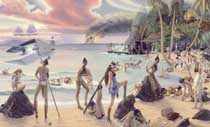
The Hilary Harkness show at Mary Boone‘s 5th Avenue gallery is the doll house birthing/killing floor we’ve come to expect from her. Notoriously and understandably slow in regards to her output, Harkness made a show that’s a collection of drawings, paintings, and a few things in between. It’s far from stop-gap though. In fact, it’s essential viewing. [Ed. note: View the busy microcosmic worlds here and on the gallery’s website, fans, for the show closed June 25.]
(top image is “Air Raid” 10 1/2″ x 10 1/4″, graphite, oil, watercolor/paper, 2005; and left above is “Flipwreck,” 13″ x 22″ oil/wood, 2004)
I like that her work disturbs so many people from so many angles. Is it the substitution of women in predatory roles that have historically belonged to men? Is it the naked power plays that still appear in the absence of men? Is it that the women in her work are shown to have power, or more to the point that they have all the power?
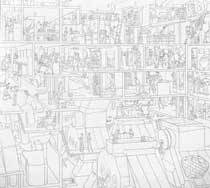
These are all interesting questions, but mostly I like that her work is so well done, both technically and intellectually. It dares you to analyze it, but it doesn’t really care what you think. It’s too involved with itself for that. The real power here is wielded by the artist, a woman in full control of color, line, and yes, her odd little tableau world of birth and bullets, water and sand. Crack that whip, Hil. Turn that knife.
(image is “Heavy Cruisers,” 18 1/4″ x 20 1/2″ graphite/paper, 2004)
Master and Commander Schutte at Marian Goodman
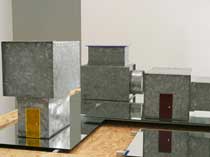
An artist that exercises a similarly high level of control in his work is Thomas Schutte. The results couldn’t be more dissimilar but he too places the viewer in the voyeur’s seat in his new show at Marian Goodman (up to July 2).
Schutte’s austere archictectural models for ‘One Man Houses’ were a jolt after the obsessive details of Harkness. That’s not to say that Schutte doesn’t have his own obsessions. The perfect form would be one of them. But the perfect form for what? That’s something that we’ll figure out as we go. (image is “One Man Houses” 2003, metal, plastic, mirror, mixed. house: 15″ x 57 5/8″ x 50″ crate 50″ x 66 1/4″ x 58″)
With Schutte’s work there is always a feeling of something left behind; something present, gone, and possible. In this work where future use is implied, there is a sense of the past that lies ahead. The viewer first peers into this world of 1:5 scale models in the front gallery. There is a smaller scale representation of the houses arranged in community in the middle gallery.
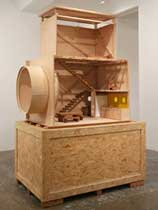
When I walked through the full-scale model room in the back gallery I felt like a camera’s eye, documenting a room with an already-unfolded secret. After the giant’s vantage point of the first two galleries, I was keenly aware of my own size and perspective — my own humanness –when I was walking around the model room. I had become the one man, and the house wasn’t the room as much as it was the created memory that was surrounding me. (image is “One Man Houses III,” 2005. house: birch, mixed. 71″ x 39 3/8″ x 69 1/2″ crate: 41 3/8″ x 48 5/8″ x 72″)
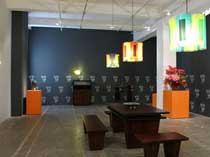
Some would argue that Schutte’s body of work and the materials he uses are an indictment of the American art world. I find that he hits a broader mark than that. Nietzsche’s idea that progress is an illusion comes to mind. By keeping his forms and materials on such a rudimentary level he reminds us of that. By taking us to another place and time, he tells us exactly where we are. (image is “One Man Houses” installation 2005)
–Brent Burket is an art collector and writer who lives in Brooklyn.









